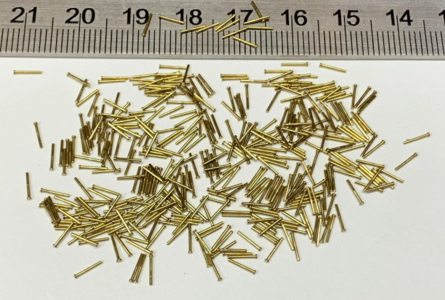I do use this technique for second planking. Now I must ask myself why I do not use it for first planking. I honestly don't know.I avoid this issue by using push pins to hold the first layer of planks in place while the glue dries. They are easier to position and insert and pull out.
You are using an out of date browser. It may not display this or other websites correctly.
You should upgrade or use an alternative browser.
You should upgrade or use an alternative browser.
- Joined
- Feb 15, 2019
- Messages
- 294
- Points
- 168

Unless you're building large scale. 1:24 say, the nail heads are way too big. If you want fixings to show on the hull pre drill with something like a 0.3 bit and use a short length of wire. The brass or copper is soft enough to be sanded with the hull. As you can see in some of these photos timber such as lime/basswood is easily damaged. Since they are unnecessary when planking you could just leave them out entirely.Looking for opinions and arguments.
Is it wise to remove the nails from the first planking after the glue has dried?
Or is it a no go?
I have performed this action on two ships so far. The first ship, Shackleton's Endurance, is still in shipshape condition three months after completion. But should I worry about the future?
I must add I pre-bent the (limewood) planks, and thus did not mount them under excessive strain. I also glued the sides of the planks, so not only the points of contact with the bulkheads
I have searched SOS in vain on this topic. Elsewhere opinions seem to be split.
The two pictures below are of HM Bark Endeavour, with and without nails.
View attachment 401786
View attachment 401787
- Joined
- Jun 13, 2022
- Messages
- 242
- Points
- 143

I am certainly in the group of modellers who pushed the pins flush with the first layer followed up with some sanding which smoothed the top of any pins slightly protruding. This is only my second model and the first using pins, hence not really thought of removing but interesting to read others comments. Just using push pins is a definitely a future consideration. Regarding the 2nd layer I actually used masking tape (Frog tape which does not leave any stickiness) to hold the plans to avoid holes although as you did see I used pins to add extra effect. Point taken from one post that pins are not in scale but I still like the effect. Complements on your first layer of planking, very neatly done.
- Joined
- Jul 31, 2022
- Messages
- 19
- Points
- 58

- Joined
- Apr 3, 2023
- Messages
- 108
- Points
- 88

For me personally, I only use nails for two scenarios... fastening deck sheets, and for double planked hulls where the frames are two thin to use planking screws. In the first case, I push them in far enough so when I layer the deck planks on top they don't create any issues. In the second case, I use a pair of very, very tiny narrow tipped pliers to pull them out. In some situations, I'll also use needle tipped hemostats as I can push them into the wood a little to grab the nail head and remove it. But for models that have thicker frames, planking screws are certainly my "go to" option. For the second layer of planking, on smaller models I'll use painter's tape to hold the thinner outer planks in place. On larger models, I'll again use planking screws until I get to the point where I need to add fillets, and for those I'll go with painter's tape again. The bottom line is that if you're using decent wood glue, you don't need the nails to remain in place for any practical structural integrity aspect. The glue will do a better job of bonding the wood parts together than a nail ever could. All always, IMHO... 

